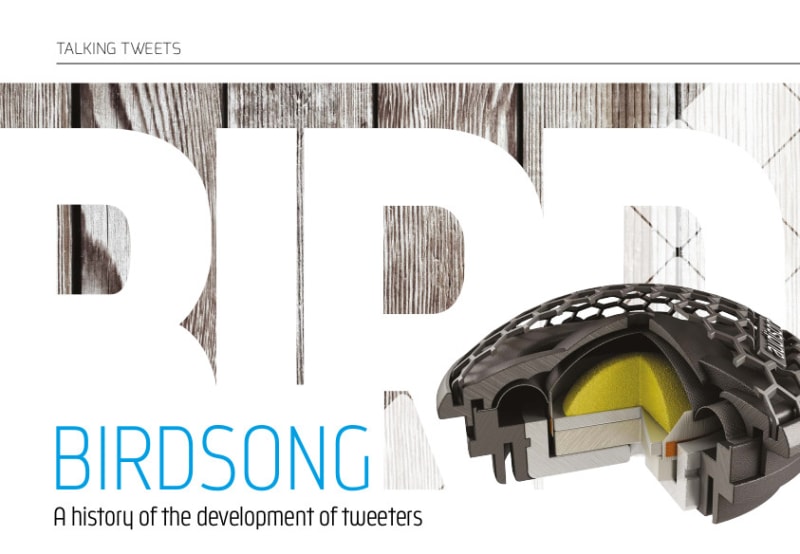
Birdsong
“A history of the development of tweeters”
Tweeters, believe it or not, are so called because they are designed to deal solely with the frequencies that birds produce. Similarly, woofers get their name from the sound of a barking dog. The delicate nature of high frequencies requires specific technology to optimise the performance of a tweeter, some of which are described below.
One has to go back to the 1950’s to find the first domestic applications of a specific speaker designed to separate delicate high frequencies away from the more brutal low frequencies in an audio system. In those early days, a tweeter was, to all intents and purposes, simply a small speaker of traditional design incorporating a magnet, a voice coil and a cardboard cone, which would reproduce frequencies from 2kHz (2000Hz) up to around 15kHz. As with all periods in history and product development, some became legendary for their comparative performance and these, as is so often the case, continue to provide a retro-fascination for some music fans seeking a nostalgic audio experience.
In the 70’s and 80’s, audiophiles wanted more from their tweeters, particularly after the introduction of the compact disc. Listeners wanted to recreate the entire audio spectrum all the way up to 20,000Hz, the scientifically accepted upper limit of human hearing. In order to achieve this, the dome tweeter was born. This shared many attributes of the cone tweeter, however, rather than a concave cone, a far faster-moving and much smaller convex dome manufactured from silk, synthetic soft material, aluminium or even titanium was developed in the pursuit of a higher reach and more linear response. The dome suited car audio better than its almost extinct cone tweeter as the dispersion characteristic was much better. However, some car manufacturers still fit highly directional cone tweeters. Why? Because they are cheap! Unfortunately, cheap ones are also mostly very nasty!
But it is not only variations in cone and dome material that have changed since the pioneering days of tweeter technology. Many other attributes have been enhanced with the introduction of new and sometimes more exotic materials. One of the main objectives has been to improve the efficiency of tweeters. The efficiency is the deciding attribute in how much power is needed to drive the speaker. The more power required, the more powerful the amplifier has to be and the more attention has to be paid to keeping the temperature of the coil and all moving parts stable. As mentioned before, high frequencies are by nature more delicate than low frequencies and so the less physical resistance in the mechanics of the tweeter, the more linear the resulting sound will be.
As far as heat dissipation is concerned, the inclusion of ferro-fluid cooling is extremely important for the linearity of a tweeter. Ferro-fluid is a specially formulated compound comprising of viscous synthetic oil with iron filings suspended in it. Various versions have been developed over the years (including some which were highly carcinogenic!). The resulting fluid is injected into the gap between the voice coil and magnet and is designed to be very good at conducting heat from the voice coil to the magnet where it can be effectively dissipated. The fluid also provides damping for the tweeter ensuring that the dome returns to its rest position smartly and in a controlled way without flapping and bouncing about, which could easily introduce unwanted resonances and other mechanical issues that may affect linearity and phase response. The fluid is held in place by the attraction between magnet and iron filings within the fluid. It remains in place for a very long time, although it is possible in the event of over-zealous cost-saving measures, to employ a fluid that will dry up over time! Other cooling measures include the material used to hold the voice coil windings.
To explain some of the finer elements of tweeter design, I would like to introduce you to the Audison Prima tweeter, probably the most advanced application of the latest technology available for the car today.
In the case of the Prima discrete tweeter (AP1 pictured), the voice coil is wound on Kapton, a material developed for space travel. Its overriding feature is temperature stability, being able to cope with temperatures from -269 to +400 degrees centigrade. This ensures that things won't go out of shape at high temperatures, often seen when current is rapidly passed through the voice coil.
Unfortunately, even the extreme efforts taken to ensure low mechanical resistance and high thermal stability are not enough to ensure a natural response and wide dispersion characteristic and therefore, Audison designers have looked to further electronic and mechanical enhancements to make the Prima tweeters sound the best they can. Using their own finite element modelling software developed over many years, they were able to look in great detail at the mechanics surrounding their tweeters and accurately predict the effect of adding to its pure design. For instance, acoustic lenses have been around for a while. The object here is to further disperse the sound from a tweeter by blocking or bouncing the sound off a physical barrier or focusing it through a tuned lens and spreading the sound out to compensate for the extremely directional characteristic of high frequencies. In many cases the design and materials used added unwanted colour to the resultant sound and actually contributed to phase anomalies. By revisiting the fundamental physics of the acoustic lens, Audison has managed to develop a lens more suited to its name! Their lens is tuned to boost frequencies between 10kHz and 13kHz as they observed that these frequencies are often reduced in a vehicle due to poorly designed speaker grilles that the tweeters are mounted behind.
The AP1 discrete tweeter’s voice coil employs copper-clad aluminium wire wound on a Kapton former and, along with the development of an ultra- lightweight cooling fluid, ensures extremely temperature-stable attributes ensuring the tweeter remains linear even when subjected to extreme contrasts of high and low energy stimulation. With many cars utilising coaxial speakers, the tweeter design within the Prima coaxial models has been completely re-thought. The tweeters now sit quite far down the throat of the woofer cone. This helps to ensure they fit behind the grilles but also adds far superior phase coupling at those important crossover frequencies where performance issues commonly occur. The result is, as Audison put it, “a disarmingly natural sound” and, having heard these myself, I have to say they sound very unlike the traditional designs of coaxial speakers I have heard before.
As with any technology-related product, marketers will often seize on technical irrelevances to hang their hats on. In the case of Audison Prima tweeters there is no one big thing that makes them stand head and shoulders above other products in their price class. No one thing that is, other than the incredibly natural, spacious sound they produce and from this customer’s perspective, this is the most important feature of all!
Find out what our partner, The FOUR MASTER Network, can do to bring Hi-Fi quality to your car. Simply put some brief details into the form below.
Not ready for that yet? You can use the same form to book a demonstration at your home, place of work or with your local FOUR MASTER
